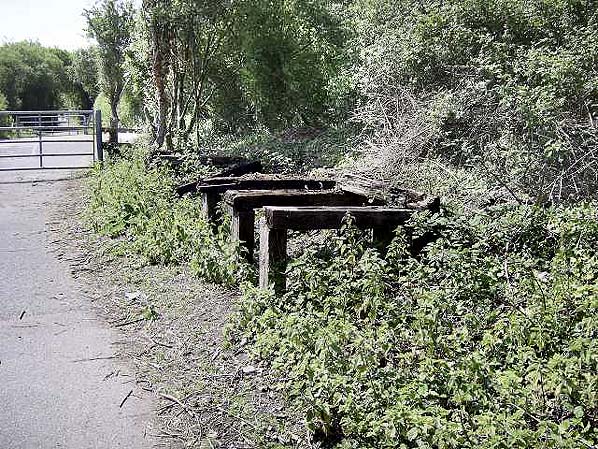|
Notes: Although never appearing in a public timetable, Cement
Mills was a public halt mainly for factory workers but also used
by fishermen and local people. Once the cement mills closed the
halt was also officially out of use but trains continued to stop
on request from fishermen and ornithologists.
BRIEF HISTORY OF THE ISLE OF
WIGHT CENTRAL RAILWAY
The railways were late in coming to the Isle of Wight. Despite
several proposals and a failed Bill the first railway didn't reach
the Island until 1862 when the Cowes and Newport Railway opened
their line between those two towns. Two years later the Isle of
Wight Railway opened a line between Ryde & Shanklin but it
was a further 11 years before the two lines were linked by the
Ryde and Newport Railway which diverged from the Isle of Wight
Railway at Smallbrook Junction, running into a joint station with
the CNR at Newport.
The Isle of Wight (Newport Junction) Railway also opened in 1875
from the IWR at Sandown through Merstone to a terminus at Newport
Pan Lane; the line was extended into the joint station at Newport
in 1879 and Pan Lane was closed. Within 10 years this line was
virtually bankrupt,
In 1887 the Isle of Wight Central Railway was formed when the
three companies amalgamated. The Newport Godshill and St. Lawrence
Railway was opened from Merstone to St. Lawrence in 1897 and to
Ventnor Town in 1900. The Isle of Wight Central operated this
line until 1913; it was then bought by the Central. Despite being
closer to the town centre than the IWR station high above the
town the new station failed to capture much traffic from its competitor.
 |
All the islands railways were absorbed into the Southern Railway
in the 1923 grouping and the service was soon upgraded with the
introduction of new rolling stock and a revised timetable that
included some through running between the various lines. The Southern
Railway itself became part of the Southern Region of British Railways after nationalisation in 1948 |
and initially there were few changes.
However this was short lived; improved bus services and the popularity
of the motor car soon led to dwindling passenger numbers. Merstone
- Ventnor was the first line to close in 1952 followed by the
former Freshwater Yarmouth and Newport Railway in 1953 and the
Newport - Sandown line in 1956.
The remaining line between Cowes and Smallbrook Junction survived
the initial wave of closures but with the end of steam on the
horizon the reprieve was short lived with the line closing to
passengers under the Beeching cuts in February 1966. Goods traffic
continued to Cowes and Newport for a few months but that too was
withdrawn by May 1966.
The southern end of the Isle of Wight Railway between Shanklin
and Ventnor was also closed allowing the remaining line between
Ryde and Shanklin to be electrified. This is still open and operated
by ex-LT tube stock as the Island
Line. The island originally had 55 1/2 miles of railways but
after 1966 only 8 1/4 miles remained open.
In 1967 there was a scheme to reopen the line between Cowes and
Ryde using railbuses, this was known as Vectrail. As part of this
scheme the Sadler 'Pacerailer' railbus was developed with a prototype
vehicle in Vectrail livery undergoing trials at Droxford
Station on the disused Meon Valley line in Hampshire. Eventually
this scheme was abandoned.
Six bogie carriages of London, Brighton and South Coast Railway
and South Eastern and Chatham Railway origin were acquired by
the Wight Locomotive Society, along with a variety of wagons,
at the end of British Railways steam services on the Isle of Wight
in 1966.
Initial restoration took place at Newport Station but in 1970
the local council acquired the station for a new bypass for the
town and the Society were required to remove their rolling stock
at short notice. Following the formation of the Isle
of Wight Steam Railway in 1971 these were then moved to Havenstreet
in January of that year. Havenstreet became the headquarters of
the railway. Gradually a five mile section of track between Smallbrook
Junction and Wootton was purchased and restored with a new station
being built at Wootton (on the opposite side of the road); this
opened in 1987. On 21.7.1991 the line was reopened westwards to
Ashey and on to a new terminus at Smallbrook Junction where new
interchange facilities are now available with the electrified
Island
Line.
Many of the islands other disused lines have now been given a
new lease of life as public footpaths and cycleways,
these include Newport - Sandown (Perowne Way), Newport - Cowes,
Wootton - Newport and Brading - Bembridge. Ticket from Brian Halford
Click here
for further selected reading
To see the other
stations on the Isle of Wight Central Railway line click on the
station name: Cowes,
Mill Hill, Medina
Wharf Halt,
Newport, Whippingham,
Wootton, Havenstreet,
Ashey, Ashey
Racecourse, Newport
Pan Lane, Shide, Blackwater,
Merstone, Godshill,
Whitwell, St.
Lawrence, Ventnor
West, Horringford,
Newchurch & Alverstone
Click here
for Isle of Wight station index
|



 Home Page
Home Page 

